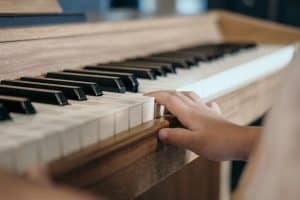Music is often described as a language of its own, with unique symbols that convey meaning. One essential part of this musical “language” is how it shows the duration of each note, in other words, how long you hold a note when playing. Musicians use specific note symbols to communicate these durations. The three fundamental note values to know are the whole note, half note, and quarter note, which are the basic units of time in music, almost like seconds and minutes in clock time. Here’s a quick overview of each:
Whole note: The longest basic note value, equal to the length of two half notes (or four quarter notes).
Half note: Half the duration of a whole note. (Two half notes make one whole note.)
Quarter note: One quarter the duration of a whole note. (Four quarter notes make one whole note.)
Understanding these three note values is crucial for reading piano music. They form the foundation of rhythm, helping you count beats and play in time. Mastering whole, half, and quarter notes will enable you to interpret sheet music correctly, so let’s dive in and see how they work together!

What are musical notes on piano?
We use notes in music for two main purposes:
- Notes give us information about the pitches we will be playing. Piano notes higher up on the staff are higher in pitch and notes that are lower on the staff sound lower.
- Notes give us information about the duration of the pitches we will play in a given piece of music. Musicians use a combination of open and closed circles with and without lines attached to them to communicate these different durations.
Parts of a written note

- Head: The round part of the note, which can be filled (for quarter notes and shorter) or open (for half notes and whole notes). The head shows the pitch when placed on the staff.
- Stem: The vertical line extending from the note head. The stem direction (up or down) doesn’t change the pitch but helps with readability in notation.
- Flag: The curved line that appears on the stem of notes shorter than a quarter note. Each flag halves the note’s duration (e.g., one flag for eighth notes, two for sixteenth notes).
Note Values
There are 7 note values (and 7 musical rests of the same duration):
whole note
half note
quarter note
eighth note
sixteenth note
thirty-second note
sixty-fourth note
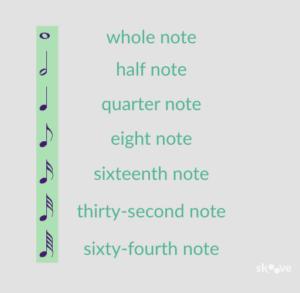
Now we understand what the parts of the note are, let’s look at a few examples.
What is a quarter note?
The quarter note lasts for one beat. Quarter notes, or crotchets, are probably the most common note type in music.
Quarter note symbol

As we see above, a quarter note crotchet consists of a closed note head (the black circle) with a stem.
We see that the note extends up if the note is below the third line of the staff. The stem will extend downwards from the left side if the note is on or above the third line of the staff. This distinction between the direction of the stem makes our music notation cleaner and easier to read.
How many beats is a quarter note?
The half note lasts for two beats. The easiest way to understand how many beats a half note gets is to play a note on the piano and count 1 – 2, then play another note and count 3 – 4 with a steady even pulse as before. Check out the diagram below to see a visual representation of counting half notes:

The diagram shows a bar of 4/4 time. To further understand bars take a look at Skoove’s’ helpful guide onreading piano music.
What is a half note?
The half note, or minim, lasts for 2 beats, or twice as long as a quarter note.
Half note symbol

The half note consists of an open note head (the open circle) with a stem extending up or down depending on where the notes are placed on the staff, as before.
How many beats is a half note?
The half note lasts for two beats. The easiest way to understand how many beats a half note gets is to play a note on the piano and count 1 – 2, then play another note and count 3 – 4 with a steady even pulse as before. Check out the diagram below to see a visual representation of counting half notes:

Improve your note values technique, learn your favorite songs and more!
What is a whole note?
A whole note consists of an open note head with no stem. It is simple and easy to read. Like the quarter note and half note, the whole note can be found on any pitch.
Whole note symbol

How many beats is a whole note?
To play a whole note you need to play a key on the piano and count as steady 1 – 2 – 3 – 4. Lift up your finger after four beats and you have the note value of a whole note. The whole note lasts the same time as four quarter notes.
Check out the diagram below for a visual representation of this note:

Tied notes, dotted notes and rests
Music, like any language, has a lot of meaning to convey. This means there is a necessity for the language of rhythm to go beyond simple whole, half and quarter notes.Tied notes connect two notes together, making them sound like one longer note. Dotted notes extend a note’s length by adding half of its original value. Not to be confused with staccato articulation dots which sit on top or below a note. There are rests which mark moments of silence which are just as important as the notes themselves. Let’s take a closer look!
What is a rest?
A rest is a symbol that musicians use to indicate silence for a specific amount of beats. Just like notes, rests come in different values:
A quarter rest or crotchet rest looks like this:

The quarter note rests, or crotchet rests, are equivalent in duration to quarter notes. This rest notates a rest for a whole beat.
A half rest or minim rest looks like this:

This rest has the same duration of two whole beats.
The whole rest or semibreve rest looks like this:
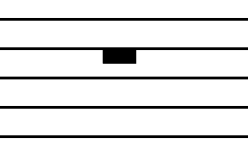
The whole note rest is shown by use of a rectangular musical symbol. This rest hangs from the fourth line of the staff. It looks similar to the half-rest symbol so make sure you don’t get the two confused.
These rests are just as rhythmically important as normal pitched frequencies of note. Take care to count them and keep them as in time as you would any piano notes for beginners you’re learning to play.
What are tied notes?
Ties look a curved line that connects two notes like this:

Remember that the whole note lasts for four beats. If we have two whole notes tied together, this means that the note values are equal to eight beats. Practice playing a note and counting a steady 1 – 2 – 3 – 4 and then again 1 – 2 – 3 – 4.
Here is another example:

What is a dotted note?
A dotted note adds half of its original value to its duration. This means a dotted half note lasts for three beats and a dotted quarter note lasts for one and a half beats.
Let’s break this down:

A standard half note is worth two beats. The dot adds half of this duration onto the note (one beat). This means a dotted half note will be worth three beats.

A standard half note is worth one beat. As before the dot adds half the value to the note (half a beat). This means a dotted quarter note is worth one and a half beats.
This exact principle applies to any note value or rest in music.
How to use dotted notes and rests in music?
Dotted notes and rests bring rhythm to life. A dotted quarter note followed by an eighth note can create a fun, syncopated feel you’ll hear in pop and rock songs. A dotted half note can add smooth, flowing movement to a piece. Rests are just as important, imagine a song with no pauses, it would feel rushed and overwhelming! To master these concepts try practicing with Skoove to hear them in action:
Comparing quarter, half, and whole notes
Let’s recap on the duration of piano rhythm and look of the note values we have studied here:

Whole note/semibreve
- Duration: 4 beats
- Looks like: open note head without a stem
Half note/minim
- Duration: 2 beats
- Looks like: open note head with a stem extending up or down
Quarter note/crotchet
- Duration: 1 beat
- Looks like: closed note head with a stem extending up or down
How to count quarter, half and whole notes?
Feeling confident in playing all of these different notes on a piano? Great! Now learn to put them into practice with Skoove.
This first example involves playing 4 quarter notes one after the other.
Play each quarter note correctly and in time, you are going to count from 1 up to 4. Play the key on each beat. Try beginning on G as in the diagram above, but once you can play and count comfortably, move around to different keys as you see fit! Be sure not to cut the fourth beat short and play it for its full duration and consider passing notes.

How was that? Let’s try another!
This next example combines quarter notes and half notes.
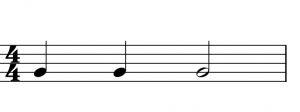
Just like the example before, play the first two quarter notes counting 1 on the first and 2 on the second. Then, count the half note over beats 3 and 4. Keep looping this with a steady pulse of 1, 2, 3, 4 and once you feel more comfortable, move on to different notes.
Music note values chart
This music note values chart shows the different note symbols and how long each one is held in a piece of music. It’s a simple guide to help you understand rhythm and note duration.
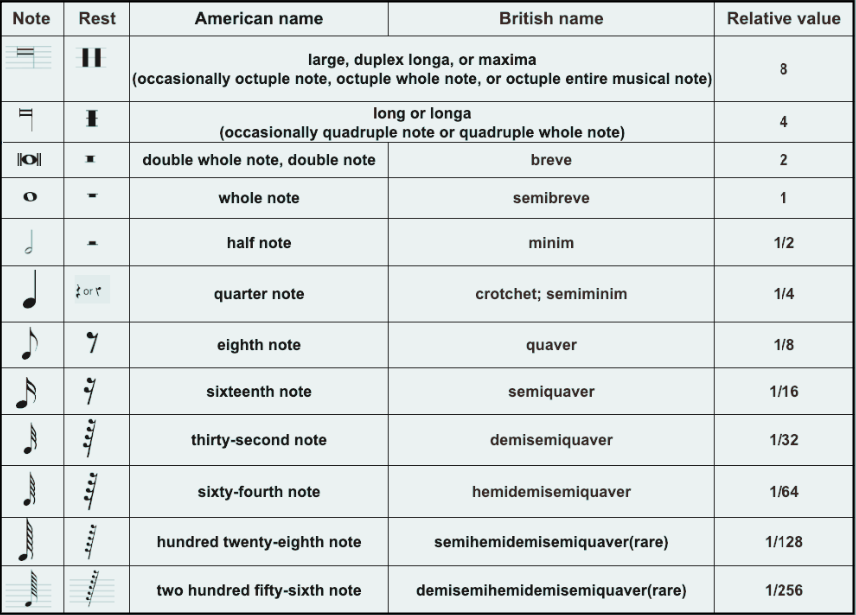
Names of note values in British
- Whole Note = Semibreve
- Half Note = Minim
- Quarter Note = Crotchet
- Eight Note = Quaver
- Sixteenth Note = Semiquaver
- Thirty-Second Note = Demisemiquaver
- Sixty-Fourth Note = Hemidemisemiquaver
Put these musical notes into practice!
A little Queen
With the Skoove app open, try to play the chorus from “We Will Rock You” by Queen.

Have a look at the music. You see quarter notes and half notes as well as tworest symbols. Practice counting along with the music before you try to play it on the piano so that you ensure youunderstand the rhythm.
Learn how to play ‘We Will Rock You’ by Queen. Start a 7 day trial today – no card details required!
How was that? Let’s play one more song!
American Pie

Now open up the app to play “American Pie.” What do you see when you sight read the music? In this song you will see examples of the quarter note, half note and whole note. Again, it will be helpful to count through the rhythm before trying to practice the piece on piano.
Learn how to play ‘American Pie’ on piano. Start a 7 day trial today – no card details required!
Find more rhythms to play
Now that you’ve built an understanding of basic rhythms, you’re ready to expand your skills. Start by exploring songs from the Skoove Piano Beginner 1 Course to practice what you’ve learned. Working with simple songs will strengthen your rhythmic foundation allowing you to approach more complex pieces later on. Remember, rhythm is key to all music and each new piece you practice will bring you closer to mastering it!









